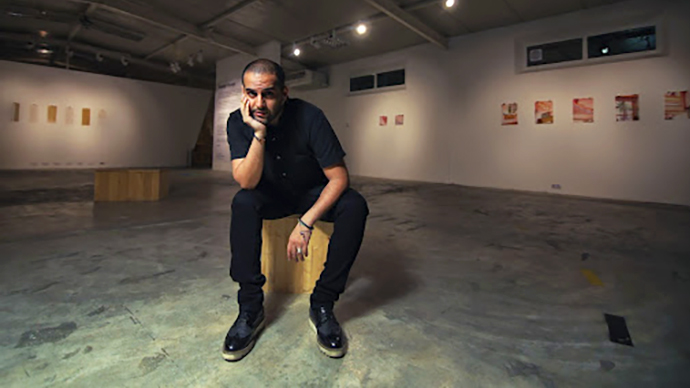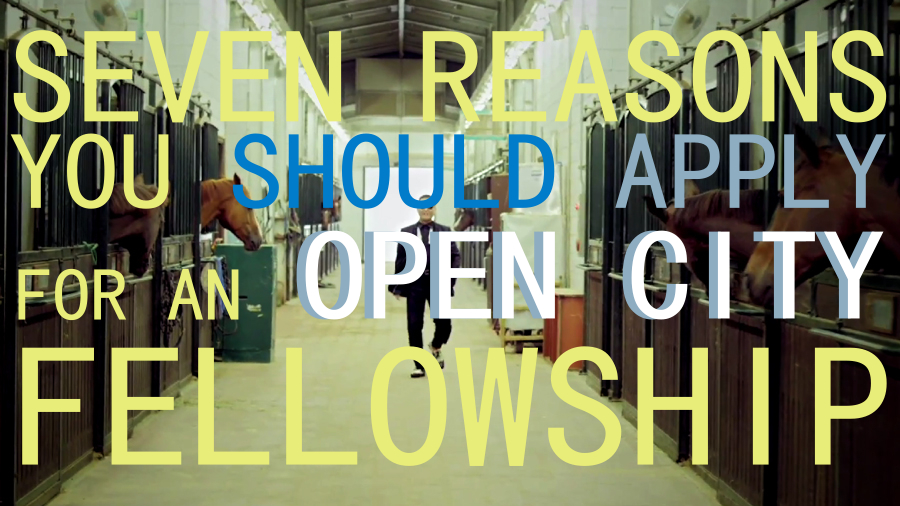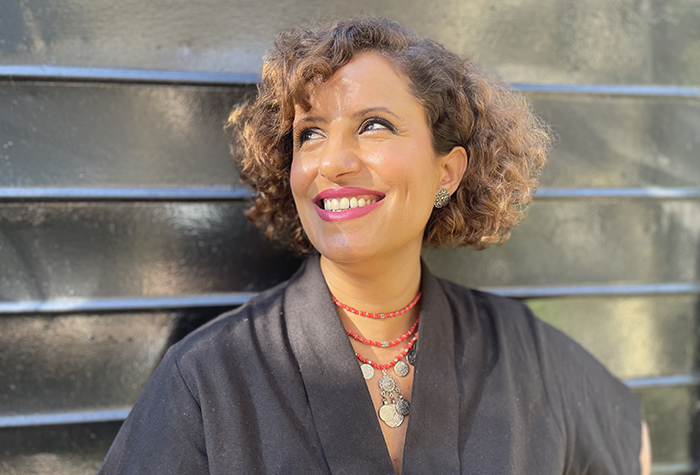Exploring art as a space for community-building with Yemeni-American artist Ibi Ibrahim

February 17, 2022
The first time I heard Ibi Ibrahim’s voice, it was through a song. A friend had sent me a track by Kabreet, the electro pop duo that the Yemeni American artist forms one half of, and I had spent the following week walking the streets of Bay Ridge, nodding my head to its ominous hook—“Ana mashi fil leil, adawwir ‘ala jawab (I walk through the night, in search of an answer).”
When the same friend offered to introduce us a month later, in the backyard of a bar in Bed Stuy, I expected to spend the time discussing Ibrahim’s next studio album or the banalities of commercial Arabic pop. Instead, he launched into an impassioned critique of the Arab art world, which he argued does a generally poor job of making space for the work of Yemeni artists. He emphasized that many of these artists work under the most trying conditions: in cities under bombardment, with frequent power outages, and a general lack of support from the dominant cultural benefactors of the region.
I found these critiques compelling. Like many Arabs, I had never sought to look beyond what I perceived as the cultural capitals of the region—Cairo, Beirut, Damascus—to discover new music, film, and visual art by Arab artists. Our conversation challenged me to.
Ibrahim was bursting with ideas of how to use his new home base of New York City to push for greater visibility for the Yemeni art scene and the Yemeni American community at large.
Over the past year, I have watched him turn many of those nascent ideas into fully-funded projects, published artwork, and community events. His documentary short A Few Minutes with Hakim, which tells the story of the young Yemeni American entrepreneur behind the popular Sunset Park coffee shop Yafa Cafe, will be on display at the Arab American National Museum in Detroit beginning in February. A selection of photographs from his ongoing photo series, “How Do You Want to be Portrayed,” was recently added to the collection of the British Museum. And earlier this month, he was announced as one of the 2022 Create Change Artists-in-Residence at the Laundromat Project.
Since our first encounter, I have learned that Ibrahim is far more than a musician. His art spans a variety of mediums, from music to film to visual art to creative writing. In addition to his artistic practice, he is the founder of the art nonprofit Romooz based in Sana’a, Yemen.
I sat down with the Bay Ridge–based artist to reflect on the evolution of his practice over the past decade and to discuss his future plans for artwork and community engagement in New York.
(This interview has been condensed for brevity and clarity.)
□ □ □ □ □
Lylla Younes
Before the pandemic, you were based in Yemen, making art and working on community engagement projects. How did you end up moving back to the U.S.?
Ibi Ibrahim
When the pandemic erupted, I was visiting Berlin for the Berlin Film Festival. Because I was working and living in a conflict zone, I was trying to take a breather every five, six months and I’m very fortunate and privileged to have an American passport and the resources to be able to get out. It was around March 2020, and the world started shutting down. I was stranded, basically, because I couldn’t find a flight back into Yemen. I tried to stall for a while, but my tourist visa ran out, so finally I booked a one-way ticket to America.
LY
Since you arrived, you’ve been creating art about Arab America. Although you were born here and have an American passport, you grew up mainly between Yemen, Iraq, Libya, and the UAE. How has existing somewhere between immigrant and American guided the work that you’ve been producing over the past couple of years?
II
I hear a lot from my fellow Arab Americans about challenges they faced growing up in this country and having to navigate those two identities. I don’t let it become a struggle. I position myself based on the environment I’m in at any given moment. Who are the people around me right now? Those are the people whose stories I want to tell, the art I want to make. When I’m here in America, I’m not going to do something on Yemen. It has to be Yemeni American. It has to be about my own community here.
LY
That reminds me of your ongoing photo series, “How Do You Want to be Portrayed.” Can you talk about the origin of that work?
II
That project happened by coincidence. In Detroit, while in an art residency at the Arab American National Museum, I had this idea to interview young Yemeni Americans, men and women, and just to have conversations about our history and navigating it, and how to document our stories of coming to America. And every time I interviewed a woman, the conversation diverted into something different entirely, into questions of justice for women in the Yemeni American community. Maybe this happened because those women saw me as an ally, I don’t know.
So in the summer of 2020, I started speaking with Yemeni women about how they want to be seen in their own communities, and I titled the project, “How Do You Want to be Portrayed.” I started doing something new that I’m not used to, which is giving the people I’m photographing control over the picture. After we take the photographs, I engage with them, see what photo they feel closest to and why. I used to be very protective of my work and I wanted full control over what photos to select, but now that practice has shifted.
LY
Does that have something to do with what you were saying earlier about shifting from being the individual artist to being more interested in creating a collective voice?
II
Exactly. And I think eventually, I’d like to see others—Syrian women, Afghani women, for example—replicate this idea. Or host panel discussions as we’ve done for my series—just bringing women around a table and asking them these questions. This is what I’m trying to do. Because when you put ownership on a project, it’s very much associated with yourself. And I find that to be in some cases problematic, and it doesn’t inspire others in the way that it does when you say, “This is our project. This is our story. This is our voice.”
LY
What response have you gotten?
II
Some people have told me that this work is groundbreaking, that it’s giving these women voices. But there’s a misunderstanding here. These women are not voiceless, there is no such thing as a voiceless Arab woman in my humble opinion, these women are fucking loud. It’s just that their voices need spaces.
LY
In addition to that project, you’ve also started photographing Bay Ridge, where you recently moved. What drew you to Bay Ridge, and to using it as a setting for your current work?
II
Well, it’s really special. I don’t want to be cliche, but when I walk out onto Fourth Avenue, it’s a reminder of home, a reminder of the people I love most, the people I grew up with. You know, to walk down the street and see a Yemeni flag hanging in the window of a store, that’s a big deal for someone who comes from a country associated with war and conflicts. A country that there is so much prejudice towards.
But these feelings get complicated too. I walk down the street and I want to pull out my phone and take photos of the storefronts and so on. You love to see yourself represented in this world of New York, but then my attention immediately goes to a woman dressed in full black, and I have this question mark. My mind goes to all the conversations that I’ve had with Yemeni women in New York and the Detroit metro area, who say that the conditions for them are harder now than they were for women who came in the sixties and seventies.
How can I put that into perspective, that the condition of a Yemeni American woman in the seventies in America was far better than where she is today? There’s no better place to explore these questions than in Bay Ridge. All neighborhoods in New York are exciting, but there’s something about this neighborhood that you can’t help but wonder where it’s gonna be in ten years.
LY
You’re the singer-songwriter of the Arabic-German pop duo Kabreet, whose song “Film Faransi” has become hugely popular since the summer. And in addition to music and photography, you have experimented with painting and video work. I’m curious, just from a practical perspective, how you juggle various mediums as you work across them? Is there a cost to context switching?
II
I remember back in 2012 telling my peers that I wanted to start doing video work. And they all said, “Don’t. Don’t do it. It will harm your career. Just stay on your current route.”
And I’m glad I didn’t listen to anybody, and I ended up making a film. Then in 2014, I really wanted to experiment with something new. I was fortunate to be in a residency at the Cites des Arts in Paris. I was buying a lot of paper to make my coffee paintings, and every time someone visited my studio they said, “Don’t do it. Don’t move away from photography to painting.”
But then I try to remember that if I don’t enjoy it, I won’t do it. So I try not to listen to those voices. I do acknowledge that I have paid the price, career-wise. But I think what helped me so much was constantly reminding myself that I was staying true to myself. I’m not a commercial artist.
LY
It sounds like technical craftsmanship is not your primary interest.
II
It’s not. I have this fear that I would get bored. What happens if I’m thirty-four and I master this photography? Where do I go from there? I like to be constantly experimental in that sense. For example, my bandmate, Hanno, and I are making new music. I feel like I’m starting from scratch, because I haven’t made new music in a year, I’m like, “Oh my god, where do you put this wire?” But there’s this excitement too, right?
LY
Speaking of your experimentation with various mediums, I remember watching your short film Departure at a film festival last year. Can you describe it?
II
Departure is a video that highlights the struggle of Yemenis stranded in Egypt and Jordan as the war erupted in Yemen. This struggle is told through the voices and stories of women. I found that as the war erupted, we didn’t hear many Yemeni women’s voices even though they were the people providing safety nets to their families during the war, since many of the men either went to war or were killed.
LY
What was the origin of that idea?
II
Funny enough, the pandemic was not the first time I got stranded in Berlin. In the summer of 2015, I was at my first ever institutional exhibition at Colorado College when the war in Yemen broke out. My original flight back got canceled so I went to Jordan, thinking that maybe I can enter Yemen through there. And I’ll never forget this moment—I was sitting on a bench in this area of Amman called Paris Circle, which was known to have a lot of Yemenis around it, and this woman sat down next to me. I could tell that she was from Yemen.
And I remember just wanting to ask her how she was feeling. Where was her home? Was she trying to go back? Was she stranded like me? So I found myself in Paris Circle asking these questions. I wanted to go home but I couldn’t so I booked a flight to Berlin thinking, “Okay, this is my home now.” But I kept thinking about that woman, and she became the inspiration for my film Departure.
LY
A conversation with you would be incomplete without a discussion of Romooz, the initiative and nonprofit that you founded in Yemen to promote the development of Yemeni art and culture. Romooz has hosted trainings, residencies, workshops, literature events, film festivals, and artist talks. What motivated you to start the organization?
II
Well, when I arrived in Berlin after the war broke out, I realized that Yemen had suddenly become this country that was perceived as a warzone and nothing else. And at that point I had never even observed that war. All I knew of my country was the experience of living there before the war.
So I had the idea to bring together Yemeni artists to share their experiences at that time. I hosted conversations and events at an art salon I started in 2015, just really small self-funded events. And through that I realized that there was a hole that I had to fill. There were simply no spaces for Yemeni artists to discuss their art and artistic practice.
LY
What’s next for you?
II
Lately I’ve been thinking, a little over a year after returning here, that I am finally able to navigate the resources available for New York–based artists, knock on doors of art spaces and be heard. I am excited about the upcoming journey of diving further into my art practice in this new environment, the stories of immigrants I want to tell and the spaces we can collectively create as we claim our own narratives.
This year, I will be creating a photo and oral history project documenting the images and experiences of Yemeni Americans. The project “Reclaiming Realities” will be developed as part of my Create Change residency at the Laundromat Project. I will photograph and interview Yemeni bodega workers across New York City, creating space for each subject to tell their personal story of coming to America and building a life here. Please join me at the Laundromat Project for my open studio on April 6.
I should also mention Arsheef (the Arabic word for “archive”), which is a collective I’m launching in early 2022 that will host programs and events focused on Yemeni arts and culture, promoting the work of Yemeni artists living in Yemen while also creating a space for the Yemeni American community to celebrate their culture here in America. I am really looking forward to the launch of the collective and to developing it with other creatives. I am always excited about this part, about the journey of creating art and artistic spaces.
It’s always been about the journey for me. That’s my joy.


